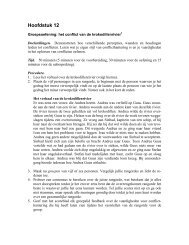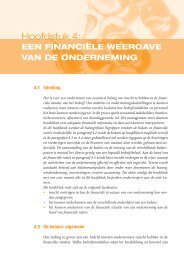Can Knowledge Management Systems Help Pfizer? - Pearson ...
Can Knowledge Management Systems Help Pfizer? - Pearson ...
Can Knowledge Management Systems Help Pfizer? - Pearson ...
You also want an ePaper? Increase the reach of your titles
YUMPU automatically turns print PDFs into web optimized ePapers that Google loves.
LAUDMC12_0131538411.QXD 2/4/05 8:59 AM Page 453<br />
Chapter 12 Managing <strong>Knowledge</strong> in the Digital Firm 453<br />
CASE STUDY<br />
<strong>Can</strong> <strong>Knowledge</strong> <strong>Management</strong> <strong>Systems</strong> <strong>Help</strong> <strong>Pfizer</strong>?<br />
Pharmaceutical companies are among<br />
the most intensive users of knowledge<br />
management systems, and you<br />
can easily see why. The drug discovery<br />
process is long and arduous.<br />
Researchers must first identify a biological<br />
target such as an enzyme or<br />
gene that appears related to a disease;<br />
fling hundreds of thousands of<br />
compounds at the target to see which<br />
interact with it; and conduct animal<br />
studies of toxicity, absorption, and the<br />
properties of the most promising molecules.<br />
If all still looks good, they<br />
would then test one of the compounds<br />
on humans.<br />
Only one new chemical entity in<br />
10,000 makes it through the U.S.<br />
Food and Drug Administration (FDA)<br />
approval process, and only half the<br />
drugs approved make it to market.<br />
The complete process costs $500 million<br />
to $700 million per drug, and<br />
each day of delay in a seven-year testing<br />
cycle for a hot new drug can cost<br />
$2.5 million.<br />
Today the stakes are higher than<br />
ever. There are very few new drugs in<br />
the pipelines of major pharmaceutical<br />
companies. Despite steadily increasing<br />
expenditures on research and<br />
development, which now totals more<br />
than $25 billion annually in the<br />
United States alone, the U.S. FDA statistics<br />
show a steady decline in the<br />
approval of new drugs, or “new molecular<br />
entities.”<br />
The pharmaceutical companies<br />
are doing everything they can to<br />
develop new products and come up<br />
with new ideas—promoting a more<br />
innovative corporate culture, forging<br />
collaborative ties with university<br />
researchers, and acquiring young<br />
pharmaceutical and biotechnology<br />
firms to obtain new sources of<br />
expertise. Any knowledge from any<br />
source that can bring a new drug to<br />
market or expedite the drug development<br />
process is obviously very<br />
valuable.<br />
Let us look at the role of knowledge<br />
management at one of these<br />
companies. <strong>Pfizer</strong> is the world’s<br />
largest research-based pharmaceutical<br />
firm. Its best-known products<br />
include Celebrex, Zoloft, Lipitor, and<br />
Viagra. In addition to prescription<br />
drugs, the firm makes over-thecounter<br />
remedies such as Bengay,<br />
Listerine, Benedryl, Visine, and animal<br />
health products. <strong>Pfizer</strong> is divided into<br />
three major business segments: pharmaceutical,<br />
health care, and animal<br />
health, with the pharmaceutical segment<br />
accounting for 88 percent of<br />
<strong>Pfizer</strong>’s total revenue.<br />
Among <strong>Pfizer</strong>’s 122,000 employees,<br />
over 12,500 are scientists who<br />
work in research labs around the<br />
world. <strong>Pfizer</strong> Global Research and<br />
Development is the industry’s largest<br />
pharmaceutical R&D organization,<br />
with a $7.1 billion budget for R&D in<br />
2003. <strong>Pfizer</strong>’s search for new drugs<br />
encompasses hundreds of research<br />
projects across 18 therapeutic areas—<br />
more than any other company. The<br />
company maintains links with more<br />
than 250 partners in academia and<br />
industry.<br />
Like other major pharmaceutical<br />
companies, <strong>Pfizer</strong> relies heavily on<br />
knowledge management systems to<br />
drive its research and development<br />
work. It has systems to manage all<br />
of the documents and pieces of<br />
data involved in developing a new<br />
drug; expertise location systems to<br />
identify scientists and knowledge<br />
leaders within the company and<br />
outside experts who are involved in<br />
drug research and development;<br />
and searchable databases of information<br />
collected during clinical trials.<br />
<strong>Pfizer</strong> has Web-based portals to<br />
manage all of the documents and<br />
other pieces of knowledge associated<br />
with the product life cycle<br />
development process, including<br />
online discussions. A discussion list<br />
capability keeps track of discussion<br />
threads.<br />
<strong>Pfizer</strong>’s Global Research Division<br />
intranet has many dozens of applications<br />
organized both geographically<br />
and functionally for virtually<br />
every area and division of the company.<br />
They include an internal telephone<br />
directory, access to scientific<br />
publications, and sharing of research<br />
findings across international borders<br />
and time zones. <strong>Pfizer</strong> linked its<br />
intranet with an extranet for managing<br />
some 500 strategic alliances<br />
so its global teams can access<br />
legacy data and collaborate on<br />
projects more quickly. Researchers<br />
can link from the <strong>Pfizer</strong> intranet<br />
to the U.S. Food and Drug<br />
Administration Internet site. A tool<br />
called E-sub enables the company<br />
to access historical data to expedite<br />
preparation of the laborious new<br />
drug applications (NDAs) required<br />
by the FDA.<br />
The company is moving toward a<br />
global approach to information<br />
management. In the past, each R&D<br />
library would look first in its own<br />
collection to locate requested articles.<br />
If the articles were not found<br />
there, public libraries and resources<br />
would be searched. If a requested<br />
article was still not found, an outside<br />
firm was commissioned to<br />
locate the article. Now <strong>Pfizer</strong> scientists<br />
can search the journal collections<br />
of each major <strong>Pfizer</strong> library<br />
from a single master list.<br />
<strong>Pfizer</strong> adopted Oracle’s Clinical<br />
application, which is designed to help<br />
pharmaceutical companies bring<br />
products to market faster. The software<br />
establishes standards and common<br />
working practices. Oracle Clinical<br />
has a capability for tracking who<br />
accesses each piece of data and how<br />
and why changes were made. It<br />
includes a subsystem for managing<br />
data definitions and can flag any data<br />
entered during a study that it cannot<br />
validate, so researchers can quickly<br />
identify problems with the data or the<br />
product under development.<br />
Definitions and amendments are<br />
automatically propagated to all<br />
locations.<br />
<strong>Pfizer</strong> was one of the pioneers in<br />
using advanced information technology<br />
for combinatorial chemistry and<br />
high-throughput screening.
LAUDMC12_0131538411.QXD 2/4/05 8:59 AM Page 454<br />
454 Part Three Organizational and <strong>Management</strong> Support <strong>Systems</strong> for the Digital Firm<br />
Combinatorial chemistry enables<br />
companies to design, screen, and test<br />
compounds very rapidly by using<br />
chemistry, molecular biology, and<br />
information technology to create and<br />
test thousands of chemical combinations<br />
at once. Previously, pharmaceutical<br />
companies had to evaluate thousands<br />
of compounds individually<br />
before finding one possible candidate<br />
for further development.<br />
Combinatorial chemistry and highthroughput<br />
screening became popular<br />
in the early to mid-1990s as a way<br />
to accelerate this process. Rather than<br />
have chemists cook up each type of<br />
molecule by hand, which could take<br />
weeks, machines would create thousands<br />
of chemicals in a day by mixing<br />
and matching common building<br />
blocks. Then robots would drop bits<br />
of each chemical into tiny vials containing<br />
samples of a bodily substance<br />
involved in a disease, such as the protein<br />
that triggers cholesterol production.<br />
A “hit” occurred when the substance<br />
and the chemical produced a<br />
desired reaction. (The testing process<br />
is called high-throughput screening.)<br />
Virtually all the major pharmaceutical<br />
companies embraced combinatorial<br />
chemistry and high-throughput<br />
screening, spending tens of millions<br />
of dollars forming alliances with<br />
smaller companies that specialized in<br />
this technology. Between 1995 and<br />
2000, <strong>Pfizer</strong> entered into 36 alliances<br />
with 29 different companies in combinatorial<br />
chemistry alone, and the<br />
number rises to 50 if you include<br />
<strong>Pfizer</strong>’s acquisitions of Warner-<br />
Lambert and Agouron.<br />
Intelligent machines churned out<br />
chemical after chemical, but almost<br />
none produced useful results. Often<br />
the machines threw so many ingredients<br />
together that the resulting<br />
chemicals were too “large” from a<br />
molecular standpoint. They would<br />
work in a test tube but would get broken<br />
down too easily in the human<br />
stomach. In one case a drug that prevented<br />
infection showed promising<br />
results in a test tube, but could not<br />
dissolve in water, which is required<br />
for intravenous drips. When chemicals<br />
were made individually, chemists usually<br />
dealt with such issues during the<br />
initial stages of development.<br />
According to Carl Decicco, head of<br />
discovery chemistry at Bristol-Myers,<br />
many chemists became fixated on<br />
creating thousands or millions of<br />
chemicals for testing without thinking<br />
about whether any of them had any<br />
real use. “You end up making things<br />
that you can make, rather than what<br />
you should make,” he says. Countless<br />
combinations of potential druglike<br />
chemicals are theoretically possible,<br />
but most of these combinations are<br />
really useless to humans. <strong>Pfizer</strong> senior<br />
research fellow Carl Lipinski, who<br />
retired in 2002, compiled a list of<br />
complex technical traits that often<br />
make chemicals difficult for humans<br />
to absorb and persuaded <strong>Pfizer</strong> to<br />
reprogram its computers so chemists<br />
would be warned if chemicals violated<br />
the “Lipinski rule.”<br />
Critics of combinatorial chemistry<br />
and high-throughput screening point<br />
out that these methods lack human<br />
insight, intuition, and intellectual<br />
creativity. Opponents believe these<br />
methods eliminate opportunities for<br />
serendipitous discovery. For example,<br />
in 1991 Schering-Plough scientists<br />
were looking for a drug to block a<br />
certain cholesterol-producing enzyme<br />
in the body. During a test on hamsters,<br />
they noticed that one molecule<br />
failed to block the enzyme but nevertheless<br />
lowered cholesterol. Some<br />
additional hand-tweaking by<br />
chemists turned the molecule into<br />
the cholesterol-lowering drug Zetia,<br />
which was approved by the FDA in<br />
2002. If a robot had tested the molecule<br />
in a test tube, it would have<br />
noted the failure but would have<br />
missed its serendipitous side effect.<br />
Because robot screeners can work<br />
only with liquids, the huge chemical<br />
libraries created by combinatorial<br />
chemistry and high-throughput<br />
screening are often placed in<br />
dimethyl sulfoxide, a standard solution<br />
for storing chemicals. In some<br />
cases the chemicals settle as a solid<br />
at the bottom of the solution or the<br />
solution containing the chemical<br />
breaks down. The drug-testing robot<br />
reaching into such mixtures may only<br />
come up with a drop of useless soup.<br />
Traditional labs avoid this problem by<br />
storing chemicals that might break<br />
down in dimethyl sulfoxide as powders,<br />
which are put into solution just<br />
before screening.<br />
<strong>Pfizer</strong> and the other major pharmaceutical<br />
companies are trying to rectify<br />
these problems. <strong>Pfizer</strong> spent over<br />
$600 million at labs around the world<br />
to ensure that the chemicals in its<br />
libraries are more druglike and<br />
diverse. It is using techniques other<br />
than combinatorial chemistry and<br />
making sure each chemical can meet<br />
Lipinski’s test. Martin Mackay, a senior<br />
vice president at <strong>Pfizer</strong>’s research<br />
labs, reports that a higher percentage<br />
of compounds at <strong>Pfizer</strong> are now making<br />
it through each stage of testing<br />
but that it will take 10 years to tell<br />
whether efforts to improve the technology<br />
are working. “We’re very confident,”<br />
he says.<br />
Other scientists echo his belief<br />
that the industry has solved its early<br />
problems with combinatorial chemistry<br />
and high-throughput screening<br />
and that the pipelines will be filled<br />
with new drugs created by these<br />
methods a decade from now. “It<br />
took a while to learn how to use all<br />
these new technologies,” says<br />
Richard Gregg, vice president of clinical<br />
discovery at Bristol-Myers<br />
research labs.<br />
A study led by David Newman of<br />
the National <strong>Can</strong>cer Institute concluded<br />
that combinatorial chemistry<br />
and high-throughput screening had<br />
failed to create a single FDA-approved<br />
drug through the end of 2002. A<br />
separate study of 350 cancer drugs<br />
now in human trials found only one<br />
that had been created with these<br />
methods, although the technology did<br />
help improve some drugs that were<br />
created by more traditional means.<br />
Some observers believe that pharmaceutical<br />
firms’ widespread use of<br />
combinatorial chemistry and highthroughput<br />
screening is one reason<br />
why there is such a dearth of new<br />
drugs today. The number of new<br />
drugs approved by the FDA each year<br />
has declined since 1996. In 2003, the<br />
FDA approved only 21 new drugs (of<br />
which one was produced by <strong>Pfizer</strong><br />
and one by Agouron), compared to<br />
56 in 1996.<br />
Sources: Peter Landers, “Drug Industry’s<br />
Big Push into Technology Falls Short,” Wall<br />
Street Journal, February 24, 2004;
LAUDMC12_0131538411.QXD 2/4/05 8:59 AM Page 455<br />
Chapter 12 Managing <strong>Knowledge</strong> in the Digital Firm 455<br />
Madanmohan Rao, “Leveraging<br />
Pharmaceutical <strong>Knowledge</strong>,” <strong>Knowledge</strong><br />
<strong>Management</strong>, March 2003;<br />
www.pfizer.com, accessed June 10, 2004;<br />
Kim Ann Zimmermann, “In Search of<br />
Experts: Pharmaceuticals Enter Next Phase<br />
of KM,” KWorld, January 2003; Helene S.<br />
Gidley, “Hand in Hand,” PM Network,<br />
August 2003; and Stephen S. Hall,<br />
“Revitalizing Drug Discovery,” Technology<br />
Review, October 2003.<br />
CASE STUDY QUESTIONS<br />
1. Analyze <strong>Pfizer</strong>’s business strategy<br />
using the competitive forces and<br />
value chain models.<br />
2. How important are knowledge<br />
management systems at <strong>Pfizer</strong>?<br />
How do they provide value to the<br />
company? How do they support<br />
the company’s business strategy?<br />
3. Evaluate <strong>Pfizer</strong>’s use of combinatorial<br />
chemistry and highthroughput<br />
screening in its<br />
business strategy? How effective<br />
has it been?<br />
4. How successful do you think <strong>Pfizer</strong><br />
will be in using its current knowledge<br />
management systems in the<br />
future?

















